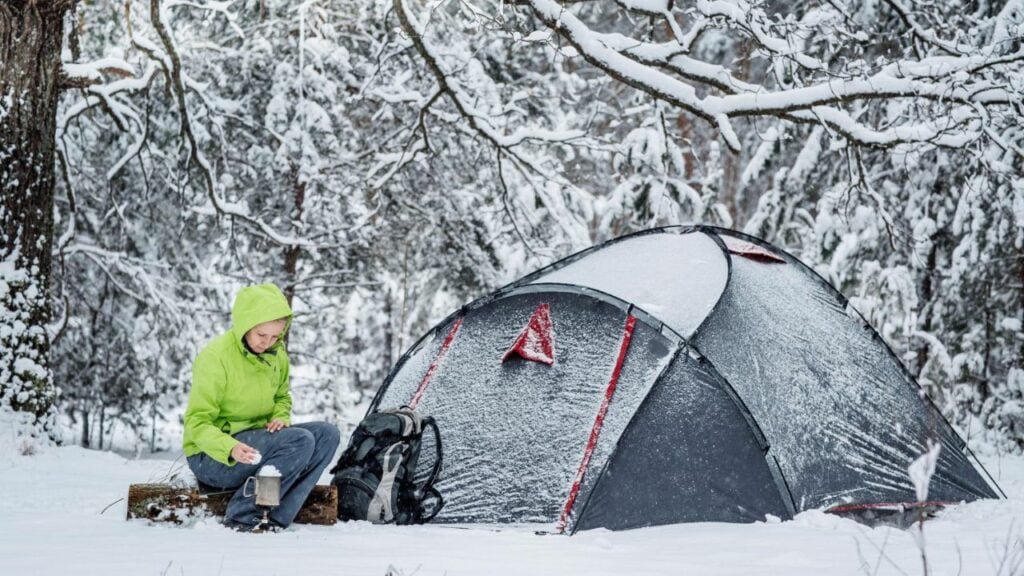We're an affiliate. We hope you love the products we recommend! Just so you know, we may collect a share of sales or other compensation from the links on this page. Thank you if you use our links, we really appreciate it!
Winter camping can be an exhilarating experience, allowing you to enjoy serene landscapes and a peaceful atmosphere. But staying warm during those chilly nights is crucial to fully appreciating this outdoor adventure.
Your campsite location, attire, and sleeping arrangements all play important roles in maintaining warmth during winter camping trips. By choosing the right spot, wearing appropriate clothing, and creating a snug sleep setup, you can stay safe, healthy, and maximize your camping experience.
With the right knowledge and preparation, winter camping can be as cozy as a summertime outing. You just have to know the tips and tricks that will help you stay toasty while braving the cold weather outdoors.
Choosing the Right Gear
One of the key aspects of staying warm during winter camping is choosing the right gear, and there are multiple categories of gear to keep in mind.
Shelter
First up, let’s discuss your winter camping shelter. A 4-season tent, also known as winter tent, is essential for protecting you from harsh weather conditions such as snow, winds, and extreme cold. Keep any eye out for insulated tents for the most warmth.
Sleeping Bag and Blankets
Selecting an appropriate sleeping bag designed for cold temperatures is crucial, as this will provide the insulation you need to keep warm. Sleeping bags with a lower temperature rating will provide more warmth. Combine your sleeping bag with a closed-cell foam sleeping pad or one with a high R-value for added insulation. A camping blanket or space blanket can add extra warmth, and is essential int he coldest temperatures.
Clothing
When it comes to clothing, layering is crucial in keeping warm during winter camping. Start with moisture-wicking synthetic base layers to keep sweat away from your skin. Avoid cotton clothing, as it retains moisture and can make you feel colder. Instead, opt for wool or synthetic fabrics that wick moisture and provide better insulation. Layering with a waterproof jacket and wearing waterproof hiking boots will keep you dry and warm. Gaiters can provide additional protection for your lower legs.
Hands, Feet and Head
Your hands, feet, and head are some of your most vulnerable parts while winter camping. For these delicate appendages, invest in warm gloves and warm socks made from materials like wool or synthetic fabrics. Adding boot liners, toe warmers, and hand warmers can provide extra heat. Don’t underestimate the importance of a good hat to prevent heat loss through your head.
Cooking
When it comes to mealtime, a liquid-fuel stove is recommended for winter camping, as it performs well in low temperatures. A camp stove is highly recommended for winter camping, because hot meals and drinks will help maintain your core body temperature. You can even look for tents with a stove jack.
Headlamp
Having a headlamp with fresh batteries is essential for safety, since days are shorter in winter and you’ll be doing a lot more in the dark.
Selecting the Perfect Campsite
When winter camping, it’s essential to choose the right campsite to help keep you warm and safe. Picking a spot at a lower elevation can help, as the temperature typically decreases with altitude. Look for a flat area that’s somewhat sheltered from the wind, such as an area surrounded by trees or tucked against a natural windbreak like a hill or rock formation.
Make sure your campsite has proper ground insulation, which is crucial to staying warm. A thick layer of snow can serve as a natural insulator, but if there’s no snow, you can use an additional ground barrier like a tarp or foam pad beneath your tent. Be sure to pack a quality sleeping pad when winter camping, as it’s an essential element in maintaining your core body heat.
Paying attention to wind direction and protection is key when setting up your tent. Position the door of your tent away from prevailing winds to avoid cold drafts and potential snowdrifts. In snowy landscapes, consider digging a small windbreak in the snow around your campsite to provide additional protection. Remember that high winds can be dangerous and make you colder, so make sure your tent is firmly secured, and use guylines as needed to keep things stable.
Managing Body Heat and Cold Temperatures

When winter camping, it’s crucial to stay warm and manage your body heat effectively. Cold temperatures increase the risk of hazards like hypothermia and frostbite. Here are some tips to help you stay warm and avoid these dangers.
Layers
Focus on layering your clothing. Wear a moisture-wicking base layer to keep sweat away from your skin, followed by an insulating layer to trap your body heat, and finally a waterproof, breathable outer layer to protect you from the elements. Adjust layers throughout the day to avoid overheating and prevent sweat buildup, as sweat can lower your body temperature when it dries.
Hydration
Staying hydrated is essential, as dehydration decreases circulation efficiency, making you feel colder. Drink plenty of fluids throughout the day, even if you don’t feel thirsty. This will help your body maintain its warmth and circulate blood more efficiently.
Insulation
Another important factor is insulation between your body and the cold ground. Use a quality sleeping pad designed for cold weather to create a barrier that keeps you warm at night. Combine this with a properly rated sleeping bag to ensure you stay warm and comfortable while you sleep.
Calories
In addition to layering and insulation, consider consuming high-calorie foods to fuel your internal furnace. Eating regular meals and snacks full of carbohydrates, proteins, and healthy fats helps your body produce and maintain heat.
Extremities
Take preventative measures to avoid frostbite and hypothermia. Keep your extremities covered with warm gloves and socks, and don’t be afraid to take breaks when needed to regain warmth and adjust your clothing. Be mindful of the weather conditions, stay informed, and always listen to your body.
Layering Techniques and Dressing Properly
When winter camping, it’s essential to dress appropriately to keep warm and avoid hypothermia. To achieve this, you’ll need to use a three-layer system for your clothing.
Base Layer
Your base layer, or underwear layer, should be close-fitting to wick sweat off your skin. This layer should be made of moisture-wicking materials like polyester or merino wool. Avoid cotton, as it retains moisture and can make you feel colder when wet. To maximize warmth, opt for long-sleeve shirts and full-length bottoms.
Mid-Layer
The middle layer is your insulating layer. Its primary function is to retain your body heat. Materials like fleece, merino wool, or synthetic fabrics like polyester are ideal for this purpose. This layer can consist of a long-sleeve shirt, a fleece jacket, and pants that provide insulation to trap heat.
Outer Layer
The outer layer, also known as the shell layer, protects you from wind and precipitation. Choose jackets and pants that are windproof and waterproof, yet breathable, to allow perspiration to escape. Many shell layers offer adjustable ventilation options like zips and vents to help regulate your temperature during activities.
Remember to include these layering techniques for your hands, feet, and head as well. Your extremities can lose heat quickly, so gloves or mittens, thick socks, and hats are essential to keep you warm in cold conditions.
To make your layering system more effective, here are a few additional tips to consider:
- Adjust your layers according to the activity. You might need to remove or add pieces based on exertion and temperature changes.
- Invest in high-quality materials and construction. Well-made garments will not only last longer but also provide better protection from the elements.
- Include extra insulation when sitting around camp in extremely cold conditions. Expedition-weight base layers or insulated pants and jackets can help keep you warm when you’re less active.
By implementing these layering techniques and dressing properly, you’ll be better equipped to stay warm and comfortable during your winter camping adventures.
Frequently Asked Questions

How to stay warm in a tent at night?
To keep warm in a tent at night, start by using an insulated sleeping pad to provide a barrier between you and the cold ground. Over this, use a high-quality, cold-weather-rated sleeping bag. You can also add some extra insulation by placing blankets or a tarp on the tent floor or using a hot water bottle or hand warmers to heat up your sleeping bag. Don’t forget to keep your tent well ventilated, as condensation can make the inside feel damp and cold.
What is the ideal clothing for staying warm during winter camping?
Layering is key when dressing for winter camping. Start with moisture-wicking base layers to wick away sweat and keep you dry. Add insulating layers such as fleece or down jackets to trap warmth, and finish with a waterproof and windproof outer layer to protect against the elements. Don’t forget to wear a hat, gloves, and warm socks, as these extremities can quickly get cold.
How to keep your sleeping bag warm in freezing temperatures?
You can keep your sleeping bag warm by using a sleeping bag liner, which adds extra insulation. Wearing warm, dry clothes to bed, such as a thermal top, bottoms, and socks can also help. Place a hot water bottle or hand warmers near your feet, torso, or any other cold spots. Make sure to fluff your sleeping bag to maximize insulation, and avoid breathing into the bag, as this can introduce moisture and reduce its insulating abilities.
What are the best heat sources for winter camping without electricity?
Without electricity, options for heat sources include portable camping stoves, propane heaters designed for safe indoor use, or even a well-stocked campfire (but remember, it’s not safe to have a campfire inside the tent). If using a non-electric heat source, always ensure proper ventilation and follow all safety guidelines to minimize the risk of carbon monoxide poisoning.

We’re passionate about getting the most from your car when it comes to going on adventures and road trips. When you take one of these trips you often need more room in your car than you usually would. This is when we come in, to help you find the best roof tent for your car and needs.

